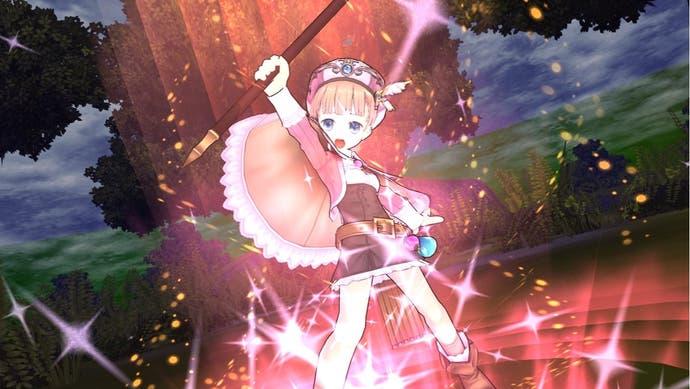Atelier Rorona: Alchemist of Arland
Chef ‘em up.
Harvesting ingredients requires Rorona and up to two hired accomplices to leave the safety of the town and head out into the wild, where they must do battle with the local wildlife. The battle system appears simple and somewhat antiquated, a turn-based affair without much flair or ambition, at least in the game's early stages we had access to.
Ingredients must be gathered from the field environment, harvest points marked with exclamation points attached to landmarks. Rorona can carry up to 60 items in her basket so it's possible to spend a decent amount of time exploring before you need to return back to the shop in order to unload and recuperate health points by sleeping on the couch there. That said, perishable items found in the wild deteriorate with time; you need to either rush back to the workshop or put them in a container to extend their life.
The council issues Rorona with a new assignment every three months of in-game time, up to a total of 12 assignments for the three-year duration of the experience. Each assignment must be successfully completed or you'll need to return to an old save and restart it, despite the fact that game has multiple branch points in terms of its core storyline.

As well as making the shop a financial success, Rorona is charged with improving its general reputation, which has been tarnished in the community by Astrid's behaviour. This is accomplished by taking on 'Front Tasks', side quests issued by the townsfolk in between the main business concerns.
Considering this is the first Atelier game to be rendered in 3D, and that it doesn't feature the hand-drawn 2D aesthetic of the previous games in the series, the visuals are something of a disappointment. Game areas are small and the uninspired lighting does no favours for the rudimentary 3D environments.
Nevertheless the cel-shade effect applied to the characters works well; these models are comparable to Level 5's earlier work in terms of detail and design. The world is navigated via 2D, watercolour maps, menu lists highlighting what enemies can be expected in each gathering location, as well as the primary items you can expect to harvest there. By contrast, the game's copious cut scenes play out with highly detailed but unanimated 2D sprites conversing in text boxes, a hotchpotch of art-styles as diverse as the ingredients in one of the game's recipes.
While Japanese players are familiar with both alchemy titles and cutesy but asinine shop-running sims, these curios are rarely translated into English. With a sequel already out in Japan, Atelier Rorona's success over there is already proven. While it seems unlikely the game will break out from the smallest of niche audiences in Europe, its release here in September is nevertheless welcome, providing some much needed spice and diversity to autumn release schedule.








